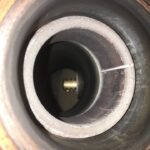Experiencing the dreaded Check Engine Light in your VW Passat, accompanied by the P205C fault code? You’re not alone. This common issue often points to a problem with the Diesel Exhaust Fluid (DEF) temperature sensor, integrated within the AdBlue tank. Many dealerships will recommend replacing the entire tank, costing you a hefty sum. However, as a fellow VW owner and DIY enthusiast, I’m here to show you a cheap and effective fix that could save you hundreds of dollars.
The P205C and sometimes P205B codes indicate that your Passat’s computer is detecting an issue with the DEF temperature sensor. This sensor plays a crucial role in monitoring the DEF fluid temperature. If it drops below -11 degrees Fahrenheit, a heater within the tank activates to prevent freezing. However, sensor failures are common, and thankfully, bypassing the need for a full tank replacement is entirely possible.
This guide will walk you through a straightforward DIY fix, perfect for those who are comfortable with basic car repairs and soldering. Whether you live in a warm climate where freezing isn’t a concern, or need a solution for colder regions, we’ve got you covered.
Before we dive in, gather these essential parts:
- A 10k Ohm Resistor or an Automotive grade 10k Ohm Submersible Thermistor. (Consider your climate when choosing – resistor for warm, thermistor for cold).
- Solder
- Heat shrink tubing
- Basic tools: Jack, Torx screwdrivers, wire cutters, soldering iron, heat gun (or lighter for heat shrink).
You can find these electronic components at online retailers like Mouser Electronics or eBay for just a few dollars. Now, let’s get your Passat back on the road without breaking the bank!
DIY Fix Options for P205C Error: Resistor or Thermistor?
There are two primary methods to tackle the P205C error, depending on your climate and level of desired complexity.
Option 1: The Simple Resistor Fix (Warm Climates)
If you live in a region where temperatures rarely dip below freezing, a simple 10k Ohm resistor is your quickest and easiest solution. This method essentially tricks the car’s computer into thinking the DEF fluid temperature is always a moderate 77 degrees Fahrenheit (25 degrees Celsius), which is the resistance value of a 10k Ohm resistor at that temperature.
Here’s how to implement the resistor fix:
-
Prepare the Vehicle: Use your car jack to safely lift the rear passenger side of your VW Passat until the tire is just slightly off the ground. This gives you access to the DEF tank area.
-
Access the DEF Tank Wiring: Locate and remove the Torx screws securing the rear fender well liner. There are typically around five of these. Gently pull back the plastic liner of your lower bumper/quarter panel. You only need a few inches of clearance to access the tank.
-
Lower the DEF Tank: The DEF tank is held in place by three bolts. Remove these bolts. Be prepared to support the tank as it comes down, especially if it’s full of DEF fluid, as it can be heavy.
-
Identify the Temp Sensor Wires: Find the wire harness connected to the filler neck of the DEF tank. The temperature sensor wires are pins 3 & 4 on this connector. They are typically purple/yellow and brown wires on the harness side, which correspond to black and white wires going into the tank itself.
-
Cut and Connect the Resistor: On the connector side (wires leading to the car’s computer, not into the tank – the purple/yellow and brown wires), cut the black and white wires, leaving enough slack to work with. Solder a 10k Ohm resistor across these cut wires. Ensure you are connecting the resistor to the wires going back to the car, effectively bypassing the sensor inside the tank.
-
Insulate the Connections: Use heat shrink tubing to insulate your solder connections and protect them from the elements. For the wires coming from the tank, which are now disconnected, simply tape or heat shrink the ends to insulate them, as they will no longer be used.
-
Reassemble: Carefully lift the DEF tank back into position and re-secure it with the three bolts. Reinstall the fender well liner and Torx screws. Lower the vehicle.
Option 2: Thermistor Fix for Cold Climates (Advanced)
For those living in colder climates where DEF fluid freezing is a real concern, using a 10k Ohm thermistor is a more robust solution. A thermistor is a temperature-sensitive resistor; its resistance changes with temperature. By placing a submersible automotive-grade 10k Ohm thermistor inside the DEF tank, you can maintain a more accurate temperature reading for the computer, while still bypassing the faulty integrated sensor.
Note: This method is slightly more complex and requires removing the DEF tank top.
-
Follow Steps 1-4 from Option 1 to access and lower the DEF tank.
-
Disconnect Tank Components: Before proceeding, take pictures of the top of the DEF tank to remember the position of all hoses, wiring harnesses, and the pump. Disconnect all wiring harnesses, hoses, and the pump from the top of the DEF tank.
-
Open the DEF Tank: Unscrew the top of the DEF tank. Remove the rubber grommet and the plastic circular housing from the tank top. This housing is typically locked in place and can be detached by twisting it counter-clockwise.
-
Locate Internal Sensor Wires: Inside the tank, find and trace the black and white wires that correspond to pins 3 & 4 on the external connector (you identified these in Option 1). These are the wires that were originally connected to the faulty temperature sensor.
-
Install the Thermistor: Solder and heat shrink the automotive-grade 10k Ohm thermistor to these black and white wires inside the tank. Position the probe end of the thermistor in the lower portion of the tank where the other sensors are located. You may need to carefully drill a small hole in the plastic housing to properly position the thermistor probe. Ensure the thermistor is submersible and designed for automotive fluid environments.
-
Reassemble the Tank: Carefully reassemble the DEF tank top, ensuring the rubber grommet and plastic housing are correctly positioned and sealed. Reconnect all hoses, wiring harnesses, and the pump to the top of the tank, referring to the pictures you took earlier.
-
Reinstall the Tank: Lift the DEF tank back into position, secure it with the bolts, and reinstall the fender well liner and screws. Lower the vehicle.
Materials and Tools Checklist
- 10k Ohm Resistor OR 10k Ohm Automotive Submersible Thermistor
- Solder
- Heat Shrink Tubing
- Torx Screwdriver Set
- Car Jack and Jack Stands (for safety, though jack stands are not strictly necessary for this procedure, jacking the car safely is crucial)
- Wire Cutters/Strippers
- Soldering Iron and Solder
- Heat Gun or Lighter (for heat shrink tubing)
- Optional: Multimeter (to verify resistor/thermistor value and connections)
Important Considerations and Tips
- Driving Cycles: After completing either fix, it may take several driving cycles (typically a few days of normal driving) for the Check Engine Light to turn off. The car’s computer needs time to recognize that the fault is resolved.
- DEF Fluid Handling: If your AdBlue tank is full, consider draining some DEF fluid before lowering the tank to make it lighter and easier to handle. If you do drain fluid, use a clean container and funnel to refill it afterwards. A VW DEF refill bottle can be helpful for controlled refilling.
- Alternative Wiring Access: If you prefer not to drop the tank completely, you might be able to access the necessary wires by locating the connector near the rear wheel and performing the resistor or thermistor fix there. Ensure you correctly identify pins 3 & 4 on the appropriate harness.
- Safety First: Always prioritize safety when working on your vehicle. Use jack stands if you are working under the car, and disconnect the negative battery terminal if you are uncomfortable working with the electrical system. However, for this procedure, disconnecting the battery is generally not required if you are careful.
Conclusion: Save Money and Fix P205C Yourself
The P205C error code on your VW Passat doesn’t have to mean an expensive trip to the mechanic. By following this DIY guide, you can effectively bypass the faulty DEF temperature sensor and clear the error code for a fraction of the cost. Whether you choose the simple resistor fix for warmer climates or the thermistor method for colder regions, you’ll be back on the road with confidence, knowing you’ve tackled this common VW issue yourself. Remember to choose the method that best suits your climate and comfort level, and always prioritize safety when working on your vehicle. Happy fixing!

